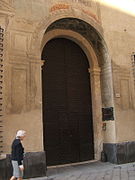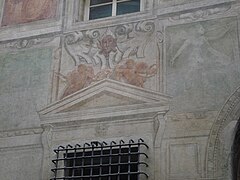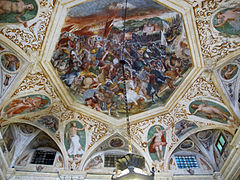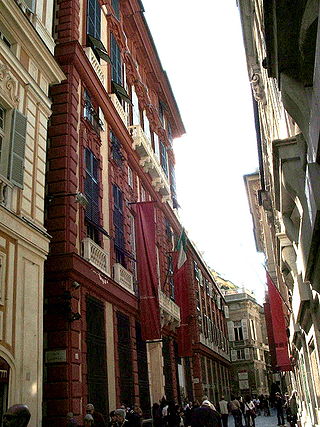
Via Giuseppe Garibaldi is a street in the historical centre of Genoa, in Northwestern Italy, well known for its ancient palaces. It is one of the Strade Nuove built by the Genoese aristocracy during the Renaissance. Since July 2006 it is inscribed in the list of UNESCO World Heritage Site Genoa: the Strade Nuove and the system of the Palazzi dei Rolli.

The Palazzo Brignole Sale or Palazzo Rosso is a house museum located in Via Garibaldi, in the historical center of Genoa, in Northwestern Italy. The palace is part of the UNESCO World Heritage Site Genoa: Le Strade Nuove and the system of the Palazzi dei Rolli. The rich art collection inside, along with the galleries of Palazzo Bianco and Palazzo Doria Tursi, is part of the Musei di Strada Nuova and consists of the works of artists of the caliber of Antoon van Dyck, Guido Reni, Paolo Veronese, Guercino, Gregorio De Ferrari, Albrecht Dürer, Bernardo Strozzi and Mattia Preti.

Genoa: Le Strade Nuove and the system of the Palazzi dei Rolli is a UNESCO World Heritage Site which includes a number of streets and palaces in the center of Genoa, in Northwestern Italy.

The Palazzo Doria or Palazzo Andrea e Gio. Batta Spinola is a palace located in Via Garibaldi, in the historical center of Genoa, in Northwestern Italy. It was one of the 163 Palazzi dei Rolli of Genoa, the selected private residences where the notable guests of the Republic of Genoa were hosted during State visits. On 13 luglio del 2006 it was included in the list of 42 palaces which now form the UNESCO World Heritage Site Genoa: Le Strade Nuove and the system of the Palazzi dei Rolli.

The Palazzo Spinola di Pellicceria, also known as Palazzo Francesco Grimaldi, is a palace located in piazza di Pellicceria in the historical center of Genoa, Northwestern Italy. The palace was one of the 163 Palazzi dei Rolli of Genoa, the selected private residences where the notable guests of the Republic of Genoa were hosted during State visits. On 13 luglio del 2006 it was added to the list of 42 palaces which now form the UNESCO World Heritage Site Genoa: Le Strade Nuove and the system of the Palazzi dei Rolli. It is currently owned by the Ministry of Cultural Heritage and Activities and Tourism and houses the National Gallery of Art in Palazzo Spinola.
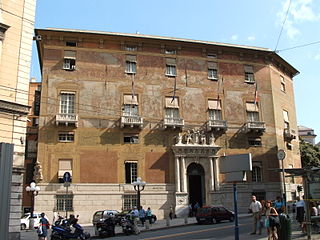
The Palazzo Doria-Spinola or Palazzo Antonio Doria is a palace located in largo Eros Lanfranco in the historical center of Genoa, Northwestern Italy. The palace was one of the 163 Palazzi dei Rolli of Genoa, one of those selected private residences where notable guests of the Republic of Genoa were hosted during State visits. On 13 luglio del 2006 it was added to the list of 42 palaces which now form the UNESCO World Heritage Site Genoa: Le Strade Nuove and the system of the Palazzi dei Rolli. The palace now hosts the Prefecture of Genoa and the seat of the Province of Genoa. It is possible to visit the areas of the building which are open to the public.
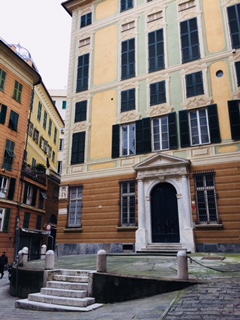
The Palazzo Clemente della Rovere is a palace located in Piazza Rovere in the historical center of Genoa, Northwestern Italy. The palace was one of the 163 Palazzi dei Rolli of Genoa, the selected private residences where the notable guests of the Republic of Genoa were hosted during State visits. On 13 luglio 2006 it was added to the list of 42 palaces which now form the UNESCO World Heritage Site Genoa: Le Strade Nuove and the system of the Palazzi dei Rolli. The palace hosts today the General Consulate of Iceland.

Via Balbi is a street in the historical centre of Genoa, in Northwestern Italy, named after the aristocratic Genoese Balbi family. It is one of the Strade Nuove built by the Genoese aristocracy during the Renaissance. Since July 2006 it is inscribed in the list of UNESCO World Heritage Site Genoa: the Strade Nuove and the system of the Palazzi dei Rolli.

Via Cairoli is a street in the historical centre of Genoa, in North-western Italy, named after the 10th Prime Minister of Italy Benedetto Cairoli (1825-1889). Built in the 18th century as “Strada Nuovissima”, it is one of the Strade Nuove inscribed in July 2006 in the list of UNESCO World Heritage Site Genoa: the Strade Nuove and the system of the Palazzi dei Rolli.

The palazzo Paolo Battista e Niccolò Interiano or palazzo Interiano Pallavicino is a building located in Piazza delle Fontane Marose at number 2 in Genoa, included on 13 July 2006 in the list of the 42 palaces inscribed in the Rolli di Genova that have become World Heritage by UNESCO.
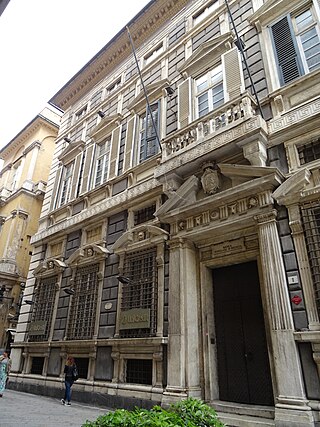
The palazzo Pallavicini-Cambiaso or palazzo Agostino Pallavicini is a building located in via Garibaldi at number 1 in the historical centre of Genoa, included on 13 July 2006 in the list of the 42 palaces inscribed in the Rolli di Genova that became World Heritage by UNESCO on that date.

The palazzo Pantaleo Spinola or palazzo Gambaro is a building located in via Garibaldi (Genoa) at number 2 in the historical centre of Genoa, included on 13 July 2006 in the list of the 42 palaces inscribed in the Rolli di Genova that became World Heritage by UNESCO on that date. The building is now the headquarters of the Banco di Chiavari e della Riviera Ligure.

The Palazzo Lercari-Parodi or Palazzo Franco Lercari is a building located at number 3, Via Garibaldi in the historical centre of Genoa, included on 13 July 2006 in the list of the 42 palaces inscribed in the Rolli di Genova that became World Heritage by UNESCO on that date.

The palazzo Baldassarre Lomellini also known as palazzo di Cristoforo Spinola or palazzo Campanella is a building located in via Garibaldi at number 12 in the historical centre of Genoa, included on 13 July 2006 in the list of the 42 palaces inscribed in the Rolli di Genova that became World Heritage by UNESCO on that date.
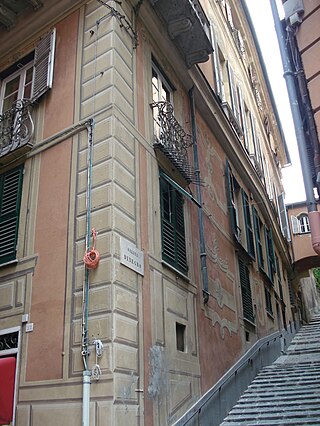
The palazzo Giorgio Spinola is a building located in Salita Santa Caterina|salita di Santa Caterina at no. 4 in Genoa, included on 13 July 2006 in the list of the 42 palaces inscribed in the Rolli di Genova that became World Heritage by UNESCO on that date.
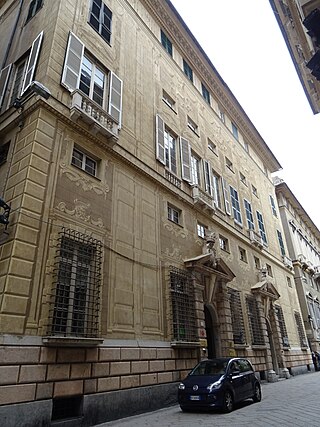
The palazzo Cattaneo-Adorno or palazzo Lazzaro e Giacomo Spinola is a building located on via Garibaldi, in the historical centre of Genoa, marked by house numbers 8 and 10, included on 13 July 2006 in the list of 42 palaces inscribed in the Rolli di Genova, which became World Heritage by UNESCO on that date. It houses a remarkable cycle of Baroque frescoes by Lazzaro Tavarone.
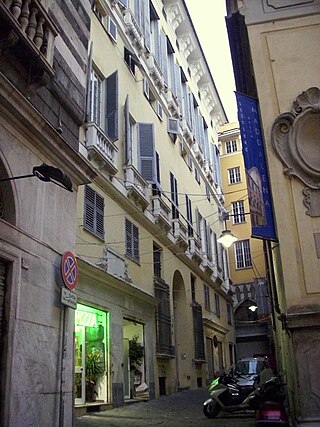
The palazzo Gio Battista Grimaldi is a building located in vico San Luca at no. 4 in the historical centre of Genoa, included on 13 July 2006 in the list of the 42 palaces inscribed in the Rolli di Genova that became World Heritage by UNESCO on that date.

The Palazzo Gerolamo Grimaldi also known as the palazzo della Meridiana is a building located in the salita di San Francesco at number 4 in the historical centre of Genoa, included on 13 July 2006 in the list of the forty-two palaces inscribed in the Rolli di Genova that became World Heritage by UNESCO on that date.
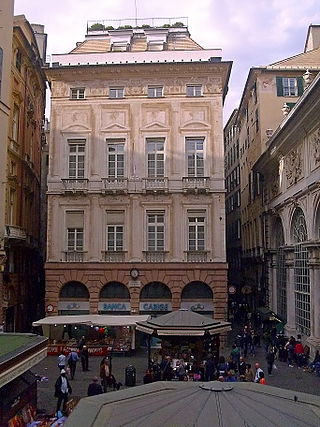
The Palazzo Ambrogio Di Negro is a building located in Via San Luca at number 2 in the area of the Mercato di Banchi in the historic centre of Genoa, included on 13 July 2006 in the list of the 42 palaces enrolled in the Rolli di Genova that became World Heritage by UNESCO on that date. It preserves an important Mannerist painting cycle inside. In front of the palace is the Loggia dei Mercanti (Genoa) and the Church of San Pietro in Banchi.

Giovanni Ponzello was an Italian mannerist architect active in the Republic of Genoa, where he supervised the construction of several distinguished palaces and churches during the Renaissance period.






















